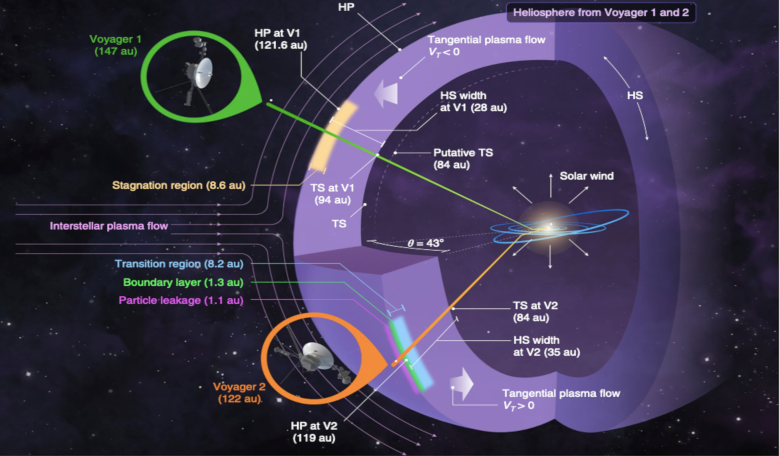There is no doubt now - evidence presented last year that the Voyager 2 spacecraft had joined its twin in interstellar space, has been confirmed as the first data from the probe as it crossed the barrier is released to the wider astronomical community.
Voyager 2, which launched slightly ahead of Voyager 1 in 1977, observed a sharp decrease in the intensity of low-energy ions and a simultaneous increase in the intensity of cosmic rays, indicating that the craft made the crossing from the outer edge of the heliosphere, called the heliopause into the cold, dense very local interstellar medium (VLISM) on 5 November 2018, at a distance of 119 times the Earth–Sun distance; a measurement referred to as an Astronomical Unit, or au for short.
Its companion, V1, the only other human-made spacecraft to have ventured as far, passed over into interstellar space six years earlier in 2012 at a distance of 121.6 au (18.3 × 109 km).
Voyager 2’s encounter with the boundary has long been anticipated by eager scientists keen to get their hands on data transmitted back by the probe, as although Voyager 1 did send some data back, somewhere en route in 1980 the probe’s plasma instrument was damaged which meant that it couldn’t gather complete data on this breakthrough moment.
Voyager 2, with all of its functionality still intact has been more successful in this regard and has rewarded researchers with a slew of much anticipated information.
So for the past year scientists have been wading through the data comparing and contrasting how the two probes experienced the passing into the relatively unknown; the results of which have been reported in several papers published in Nature Astronomy this week.
First up is the perhaps surprising news that Voyager 2 took just one day to pass through the heliopause states John Richardson at the Kavli Institute for Astrophysics and Space Research and Department of Physics, Massachusetts Institute of Technology and colleagues in one of the studies.
Not only that says Richardson, but the interstellar medium closest to the boundary is more variable and hotter than expected. Their paper, which presents the first measurements of plasma at and near the heliopause and in the VLISM, shows that the temperature in this region is 30,000–50,000 K, whereas models and observations predicted a VLISM temperature of 15,000–30,000 K.
This higher temperature suggests either more compression of the plasma than predicted or heating by reconnection says Richardson and co-authors.
Before Voyager 1 made the crossing to the other side, the data it sent back gave researchers at the time cause to think that the probe got caught up in two interstellar flux tubes; a kind of magnetic portal known as an interstellar flux transfer event.
This occurs when the magnetic fields from two different objects briefly become connected through a tube-like magnetic structure. A similar process regularly occurs between the Earth and Sun’s magnetic field, so it would be no surprise to find the same thing happening between the Sun’s (magnetic) field and the interstellar field.
Unlike Voyager 1 however, Voyager 2 did not come across this phenomena, reports Edward Stone at the California Institute of Technology, Pasadena and co-authors. This was partly due to declining solar activity and the different paths that the two craft took to break through the barrier.
But Voyager 2 did experience a whole raft of other magnetic experiences from discovering a ‘magnetic barrier’ in the heliosheath adjacent to the heliopause as well as a stronger interstellar magnetic field directly beyond it.
“These observations, together with the Voyager 1 observations and existing models, show that the magnetic barrier, the heliopause and the neighbouring very local interstellar medium form a complex interconnected dynamical system,” writes Leonard Bulgara at NASA Goddard Space Flight Center and colleagues in another paper submitted to Nature.
These detailed differences are yet to be explained, and may be partially due to temporal changes related to the Sun’s dynamic solar cycle.
It is not just the immediate surroundings which are of interest to scientists, but also what shape the heliopause is too. It is generally expected that the heliopause will be comet-shaped, and could therefore extend for several thousand au in the downwind direction.
If it isn’t and if the interstellar plasma is magnetically dominated, the resulting heliopause should instead be spherical.
Both Voyager spacecraft crossed the heliopause near the nose region (that is, in the approximate direction of interstellar inflow), so there are no direct observations of the downwind tail region.
Consequently, Stamatios M. Krimigis at the Applied Physics Laboratory, Johns Hopkins University and colleagues used another method to try and ascertain the heliopause’s shape.
Using data collected from the Low-Energy Charged Particle (LECP) instrument on Voyager 2, which is nearly identical to that flown on Voyager 1, the team say that observations close to the heliopause show relatively large magnetic field magnitudes. As such these could be sufficiently large to form a spherical and bubble-shaped heliosphere.
More direct observations from the Voyager spacecraft are needed to ascertain the shape and as both Voyagers move further into interstellar space and send back new and unique data this could help settle the debate as to whether Earth is contained in a bubble or not.
Unfortunately, it is going to be at least another 25 years, if not more, before another craft will cross this boundary again and although Voyager 1 has been edging into interstellar space at rate of ~3 au yr–1, neither can continue indefinitely as they will eventually run out of power.
It is unclear when or if a follow-up mission will again reach the distances the Voyager craft have achieved, but plans for an interstellar probe are being looked at by the COSPAR (Committee on Space Research) Panel on Interstellar Research.











